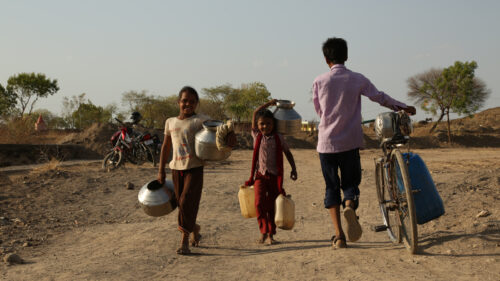Table of Contents
Maharashtra’s Water Banks: A Looming Banking Crisis without a Bailout Option

In the 1860s, England was facing an acute shortage of coal. Some experts contended that improving technology would reduce coal consumption. But contrary to this, technological improvements that increased the efficiency of coal led to the increased consumption of coal in a wide range of industries. English Economist William Stanley Jevons argued that technological progress could not be relied upon to reduce resource consumption. Maharashtra is facing a similar issue in 2020 with water.
The Paradox of water
In 2014, the then Chief Minister, Devendra Fadnavis, launched a flagship project to make rural Maharashtra drought-free. The program aimed to make 5000 villages free of water scarcity every year. Nearly 52% of the state’s geographical area is prone to drought, either naturally or due to poor rainfall. The project targeted strengthening and streamlining existing water resources like canals, bunds, and ponds by arresting maximum run-off rainwater during the monsoon. The key aim of this project, Jalyukta Shivar Abhiyan, was to establish the belief in a farmer that “every drop of rainwater is owned by me and it should percolate on my land”. Despite the efforts made by the State Government and several NGOs working in the sector, the groundwater level has continued to decrease in 245 Talukas since 2014-15.
Despite a lot of work and spending more than 9000 crores on the supply-side of water, villages are still facing drought-like scenarios. This is mainly due to unprecedented rates of extraction, the sudden availability of abundant water leading to use of more water and erratic rainfall.
This is a classic example of Jevon’s Paradox. The fault lies not with the farmers but with the policy’s design and implementation. Jevon’s paradox is a widespread phenomenon that most of us have experienced at some point or the other. For example, when we get a salary increment, we end up saving the same amount or sometimes even less than before.
Indian laws treat water as private property. It is often attached to the land. As a result, only a privileged few have access to groundwater. There is a limit to harvesting water in any location. With only 23% irrigated land, Maharashtra is heavily dependent on the monsoon. Due to climate change, rainfall is also becoming erratic. Despite this, the areas under sugarcane plantations, a water-intensive crop, are increasing every year. If this continues, we will see a huge crop failure and mass migration in the coming years.
Understanding the Water Bank
To address this the focus needs to shift from the supply-side to the demand-side of water. Implementation of water budget plans can help to deal with this challenge. The preparation of village water charts, water budget, aquifer mapping and their management was proposed back in the Maharashtra Groundwater Act, 2009.
Water budgeting is similar to balancing a bank account. In simple terms, the water budget is a process of calculating water requirements for overall different needs (domestic, irrigation, etc.) against the total water available from different sources (eg: rainfall, groundwater).
Managing water is similar to managing finances. First, similar to knowing how banks and money work, villagers need to know how aquifers and groundwater work. To understand this a 3D model of topography and aquifer map can be made available for all villages. This map can be used to convince villagers to look at groundwater as a common good.
Secondly, managing finances requires information about the inflow and outflow of money. In the same way, villagers need to measure rainfall, water level and its use. In order to achieve this, villagers should be trained in making rain gauges and measuring and maintaining the rainfall record. There is also a dire need to spread awareness about the water requirements of different crops. Water availability and water requirement of different crops will help villagers plan their crop cycles to maximise profits giving first preference to drinking water.
Finally, like a bank manager, we need to develop local leadership who will act as watershed managers. These managers need to be educated about the benefits of the water budgeting process and have the capacity to have systematic, well-planned discussions with all stakeholders to make water budgets implementable.
With climate change looming around the corner, the government needs to relook at the water crisis at the earliest. A good start would be implementing the Maharashtra Groundwater Act and incentivising water-efficient crops. We need to realise that if this crisis continues and the water banks fail, no one will be able to bail us out, as in the 2008 financial crisis.
References
WoTR. (2020b, March). Water Stewardship and Water Budgeng: A Pathway to manage the water available in a me of growing water scarcity in rain fed Maharashtra. https://wotr.org/. Retrieved March 31, 2022, from https://wotr-website-publications.s3.ap-south-1.amazonaws.com/Policy_Brief_WSI_2_Mar_2020.pdf
WoTR. (2019). Water Budgeting Tool for improving water governance at local level. https://wotr.org/. Retrieved March 31, 2022, from https://wotr-website-publications.s3.ap-south-1.amazonaws.com/Water_Budgeting_Brochure_English.pdf
Paani Foundation. (2016, June 1). Water Budgeting [Video]. YouTube. https://www.youtube.com/watch?v=svGirbOuWhQ
Narendra Kulkarni
Narendra has worked with Paani Foundation as a Content Strategist. He has also worked on nurturing Public-Private Partnerships for rural development while working as a Chief Minister’s Fellow with the Government of Maharashtra.



